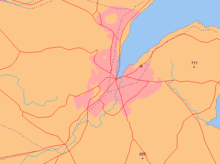Name
Each side of the square is named according to its geographical location, i.e. Donegall Square North, South, East and West. It is named after the Donegall family. Other streets to bear their name in Belfast are Donegall Road, Donegall Pass and Donegall Street. Donegall Place, the city's main shopping street, runs from the north side of the square.
Notable buildings and businesses
Notable buildings on the square include the Linen Hall Library and the Scottish Provident Building, now a five-star serviced office business centre. The Ten Square Hotel on Donegall Square South was originally a Victorian linen warehouse. Its exterior features carved portholes, with the faces of George Washington, Sir Isaac Newton, Michelangelo and William Shakespeare protruding.
On the square are many bank and society branches, including HSBC, Nationwide, Irish Nationwide, Santander, Bank of Scotland, Halifax, Co-operative Bank, First Trust Bank, Bank of Ireland, Danske Bank and Ulster Bank. Many of the above have their Northern Ireland headquarters on the square. The Northern Bank robbery occurred at the bank's headquarters on Donegall Square West. In addition, it is home to many law firms, including Millar McCall & Wylie, Sullivans, Rice & Company, McGriggors LLP, and Ferguson Solicitors.
This page is based on this
Wikipedia article Text is available under the
CC BY-SA 4.0 license; additional terms may apply.
Images, videos and audio are available under their respective licenses.


